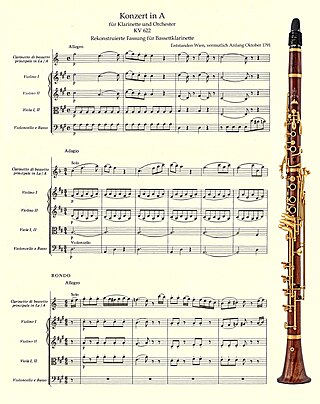Related Research Articles
The clarinet is a single-reed musical instrument in the woodwind family, with a nearly cylindrical bore and a flared bell.

John Alexander Brymer OBE was an English clarinettist and saxophonist. The Times called him "the leading clarinettist of his generation, perhaps of the century". He was largely self-taught as a player, and he performed as an amateur before being invited by Sir Thomas Beecham to join the Royal Philharmonic Orchestra in 1947. He remained with the orchestra until 1963, two years after Beecham's death.

Sir Colin Rex Davis was an English conductor, known for his association with the London Symphony Orchestra, having first conducted it in 1959. His repertoire was broad, but among the composers with whom he was particularly associated were Mozart, Berlioz, Elgar, Sibelius, Stravinsky and Tippett.
Johann Christoph Denner was a German woodwind instrument maker of the Baroque era, to whom the invention of the clarinet is attributed.

Robert Thurston ("Bob") Dart was an English musicologist, conductor and keyboard player. Along with Nigel Fortune, Oliver Neighbour and Stanley Sadie, he was one of Britain's leading musicologists of the post-World War II generation. From 1964 until his death he was King Edward Professor of Music at the University of London, based at King's College London.

The basset horn is a member of the clarinet family of musical instruments.

The basset clarinet is member of the clarinet family similar to the usual soprano clarinet but longer and with additional keys to enable playing several additional lower notes. Typically a basset clarinet has keywork going to a low (written) C or B, as opposed to the standard clarinet's E or E♭. The basset clarinet is most commonly a transposing instrument in A, although basset clarinets in C and B♭ and very seldom in G also exist. The similarly named basset horn is also a clarinet with extended lower range, but is in a lower pitch ; the basset horn predates, and undoubtedly inspired, the basset clarinet.

Wolfgang Amadeus Mozart's Clarinet Concerto in A major, K. 622, was completed in October 1791 for the clarinettist Anton Stadler. It consists of three movements, in a fast–slow–fast succession.
Emma Johnson is a British clarinettist, who was appointed MBE for services to music in 1996.

Reginald Clifford Kell was an English clarinettist. He was noted especially for his career as a soloist and chamber music player. He was the principal clarinettist in leading British orchestras, including the London Philharmonic, Philharmonia, and Royal Philharmonic, and was also active as a solo recording artist.
Harmonie is a German word that, in the context of the history of music, designates an ensemble of wind instruments employed by an aristocratic patron, particularly during the Classical era of the 18th century. The Harmonie would be employed for outdoor or recreational music, or as a wind section of an orchestra. Music composed for Harmonie is often called Harmoniemusik.
Frederick John Thurston was an English clarinettist.
David Campbell is a British clarinettist.
Alan Ray Hacker was an English clarinettist, conductor, and music professor.
Johannes Brahms's Clarinet Quintet in B minor, Op. 115, was written in 1891 for the clarinettist Richard Mühlfeld. It is scored for a clarinet in A with a string quartet. It has a duration of approximately thirty-five minutes.
Antony Pay is a classical clarinettist. After gaining a place with the National Youth Orchestra of Great Britain, with whom he performed the Mozart clarinet concerto at the age of 16, he studied at the Royal Academy of Music and then read Mathematics at Cambridge University, graduating in 1966.
Antoine-Pierre de Bavier, also known as Antoine de Bavier and Anton von Bavier was a twentieth-century Swiss clarinettist and orchestral conductor.
David Bourque is a Canadian musician, was a member of the Toronto Symphony Orchestra from 1983 to 2011. He played clarinet and bass clarinet in the TSO, and he has played on numerous film soundtracks. Bourque teaches in higher education at the University of Toronto and teaches regularly at the Jacobs School of Music at Indiana University.
Manuel Gomez (1859–1922) was a Spanish clarinettist and founding member of the London Symphony Orchestra. Gomez is believed to have been responsible for introducing the Boehm system to the United Kingdom.

The Tonkünstler-Societät was a benevolent society for musicians in Vienna, which lasted from the mid-18th century to the mid-20th. Its purpose was "to support retired musicians and their families". Beginning in 1772, the Society mounted a series of benefit concerts, often with large forces of performers, at which were performed works by leading Classical-period composers, including Joseph Haydn, Wolfgang Amadeus Mozart, and Ludwig van Beethoven.
References
- ↑ Pratt, George. ""Lawson, Colin."". Grove Music Online. Oxford Music Online. Retrieved 16 January 2012.
- ↑ Lawson, Colin. ""Chalumeau."". Grove Music Online. Oxford Music Online. Retrieved 11 June 2016.
- ↑ ""University recognises twelve honorary graduates during summer graduation."". Archived from the original on 11 January 2017. Retrieved 12 June 2016.
- ↑ "Colin Lawson". Debrett's People of Today. Debrett's Limited. Retrieved 17 January 2012.
- ↑ "Royal College of Music". Archived from the original on 7 December 2013. Retrieved 29 November 2013.
- ↑ "Clarinet Classics". Archived from the original on 22 October 2011. Retrieved 17 January 2012.
- ↑ ""C.B. Oldman Award."" . Retrieved 18 May 2020.
- ↑ ""Birthday Honours 2016: the Prime Minister's list."" (PDF). Retrieved 10 June 2016.